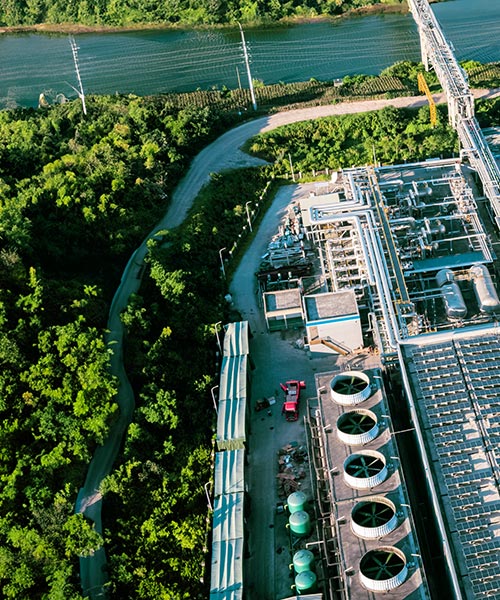February 08, 2024 • 5 min read
Can the alcohol to jet pathway solve the growing sustainable aviation fuel demand challenge?
The aviation sector needs more sustainable fuels. What role could the alcohol to jet fuel process play in enabling sustainable aviation fuel production at scale?
“The US Government’s Sustainable Aviation Fuel (SAF) Grand Challenge has set ambitious goals,” says Omar Hamid, Group Manager – Low Carbon Fuels. “It aims to scale up SAF production to 35 billion gallons by 2050. But the challenge is whether the transport fuels industry can achieve these ambitions.”
Hamid is an expert in lower carbon transport fuels. Together with Dave Collings, Principal Consultant, Worley Consulting, they’re exploring the potential of the alcohol to jet (ATJ) pathway to help meet SAF mandates.
“The US isn’t an exception,” says Hamid. “The world over has ambitious SAF targets. The EU has introduced a mandate to reach 20 percent blend of SAF by 2035 and over 60 percent by 2050. But meeting demand with current SAF supply pathways, which are dominated by the hydroprocessed esters and fatty acids (HEFA) process is unlikely to keep pace. That’s because the feedstocks it needs – such as tallow and vegetable oil – are expensive and hard to source at scale.”
Ethanol yield per acre is six times higher than oils used in the HEFA process. And US ethanol production is much larger, too. So why hasn’t the ATJ pathway experienced wide scale and cost competitive adoption?
Alcohol to jet faces challenges that impact its commercial viability
“Several barriers are limiting the uptake of ATJ,” says Collings. “For example, the cost of ATJ is typically higher than the cost of the HEFA process.
“Recent fluctuations in prices, like the spike in vegetable oil feedstock in 2022, momentarily favored ATJ over HEFA,” continues Collings. “This could happen again when the buildout of soybean oil crushing facilities consumes the remaining soybean production in the US. But to make conditions more favorable for ATJ, the cost reduction needs to be more sustainable. As the technology matures and wider ATJ adoption takes place, we’ll see a gradual reduction in cost.”
The second obstacle revolves around ensuring a sufficiently lower carbon intensity of the ethanol source used for ATJ production.
Why alcohol to jet still holds promise for aviation fuel producers
Despite the challenges, ATJ is still a viable technology for SAF for several reasons. One of which is the scale of ethanol production.
“Ethanol production is happening at a much higher volume than fats and oils,” explains Collings. “This puts the ATJ pathway at a significant advantage in mitigating the risk of feedstock constraints. While it may require almost twice as much ethanol for ATJ production compared to the fats and oils needed for HEFA, the higher availability and lower cost of ethanol can make ATJ more attractive.”
There’s also the prospect of demand for ethanol based gasoline decreasing.
“This will lead to increased surplus of corn based ethanol for ATJ,” Collings says. “Additionally, the adoption of second generation ATJ technology may increase ethanol availability even further, as it utilizes various cellulosic materials such as sugar bagasse for ethanol production. Not only does this mean more ethanol for ATJ, but it also means that ATJ won’t compete with food crops.
The adoption of agricultural wastes as feedstock is an important development, too, Notably, the global agriculture sector’s release of methane during the decomposition of crop residue in fields. Converting these agricultural wastes into SAF through ATJ processes mitigates these emissions, resulting in a net reduction in greenhouse gasses.
Alcohol to jet players are backing their processes
As a result of ATJ’s advantages, projects are forging ahead. With support from major investors, like Bill Gates who pledged a total of US$50 million to LanzaJet in 2022, some are scheduled to come online in regions like the EU and US this year. This is happening as incentive programs like the EU Innovation Fund and US Inflation Reduction Act drive interest in lower carbon fuel production including SAF.
Hamid says, “We’re seeing critical projects like LanzaJet’s Freedom Pines come online and demonstrate their process plant technology to the world. This provides the opportunity to prove their technology that was jointly developed with the Pacific Northwest National Laboratory. The startup and success of this project will derisk and improve the viability of other, much larger, projects under development. This includes those by Summit Next Gen, Gevo, and ADM who are considering other technologies such as Axens and Gevo, and Honeywell UOP’s ATJ offerings.
“Praj Industries is also laying the foundations of ATJ in India. It hopes to boost widescale adoption of ATJ in the country, curbing CO2 emissions within its aviation industry. They are combining their own 2G ethanol process with Axens’ and Gevo’s processes to produce SAF from agricultural residue. These are major players who recognize its potential.
“And the more projects like these that come online, the more likely we’ll see its widescale adoption.”
With more incentives and support, alcohol to jet could be viable even sooner
Ongoing investments, innovative approaches, and supportive incentives signify a growing commitment to overcoming the challenges of the ATJ pathway.
“ATJ technology is continuously advancing, with efficient conversion processes and advanced catalysts likely to enhance production scalability and decrease overall costs,” Hamid says. “This could make ATJ increasingly competitive.
“If the industry achieves economies of scale and reduces production costs, we'll see additional investment. These projects should further benefit from current and future SAF incentive programs, too. As these factors align, ATJ is set to play a significant role in the aviation sector's transition towards a more sustainable future.”







